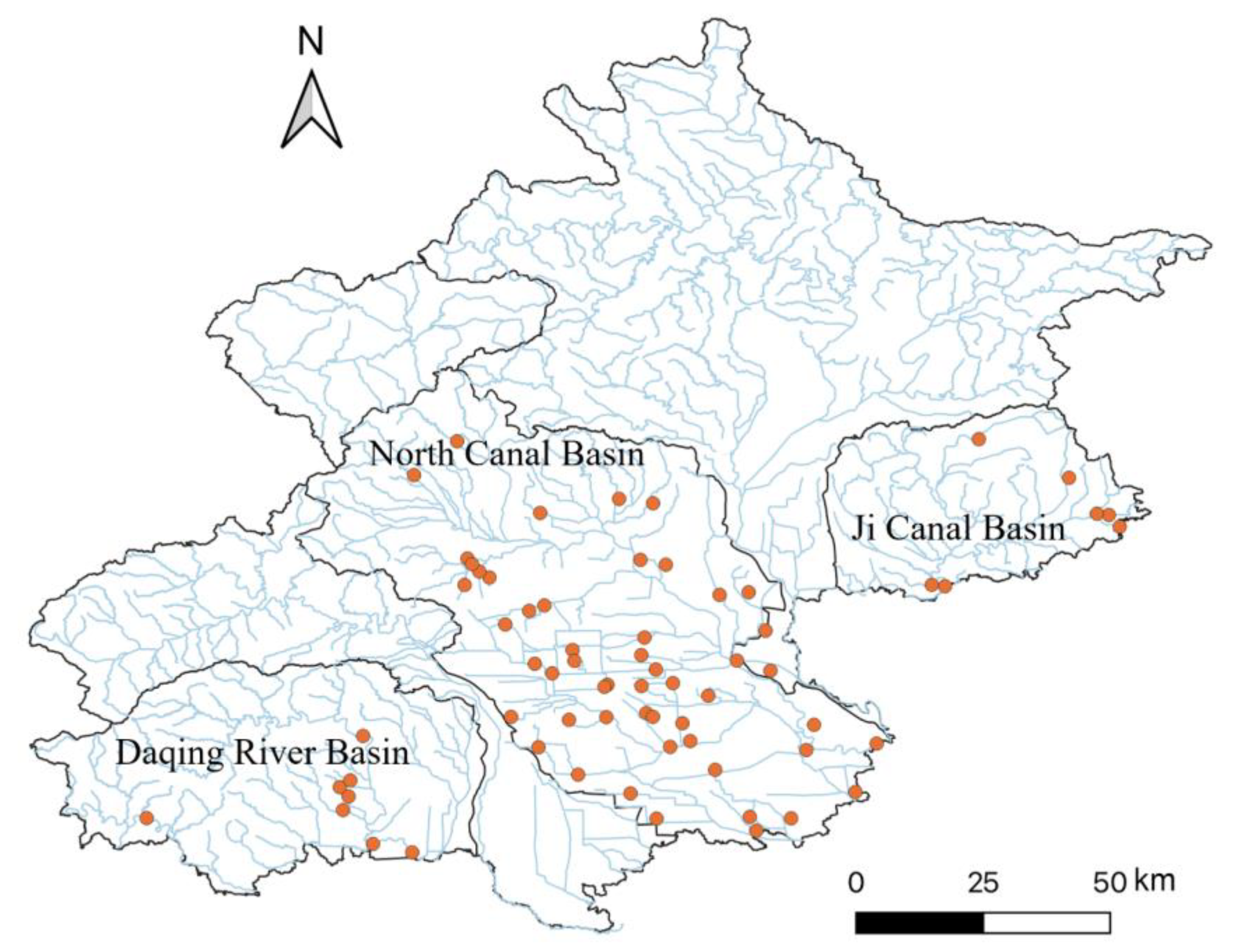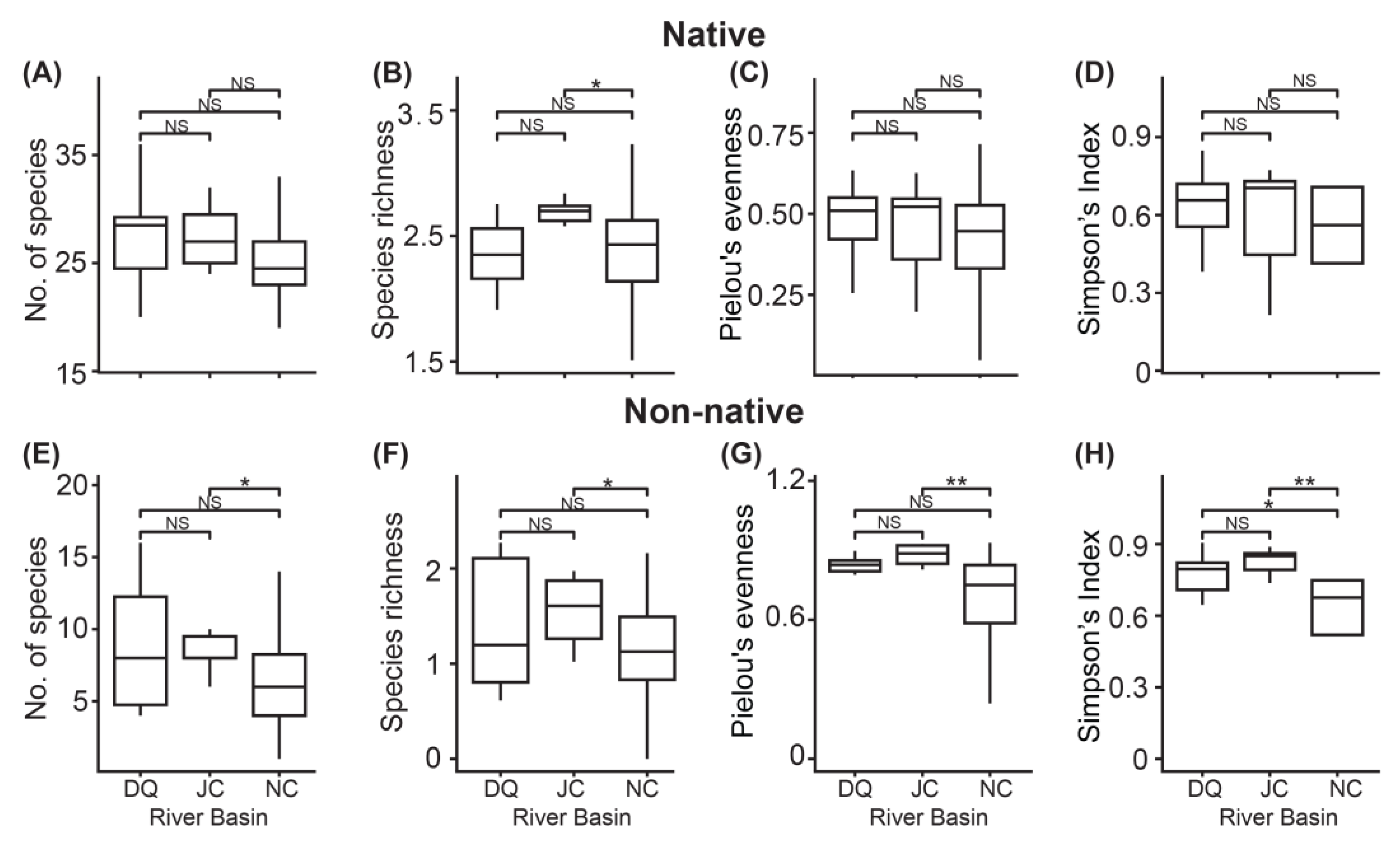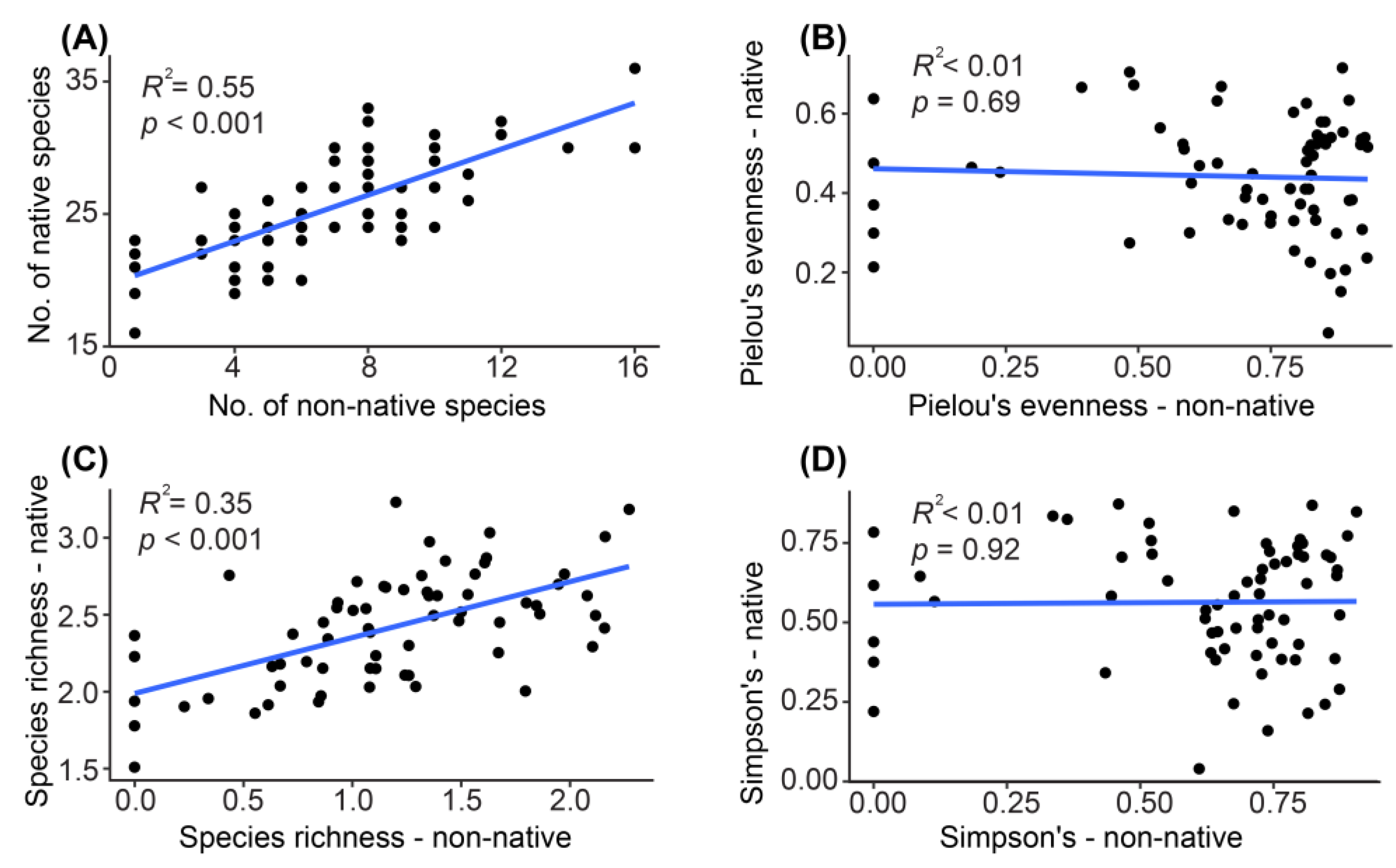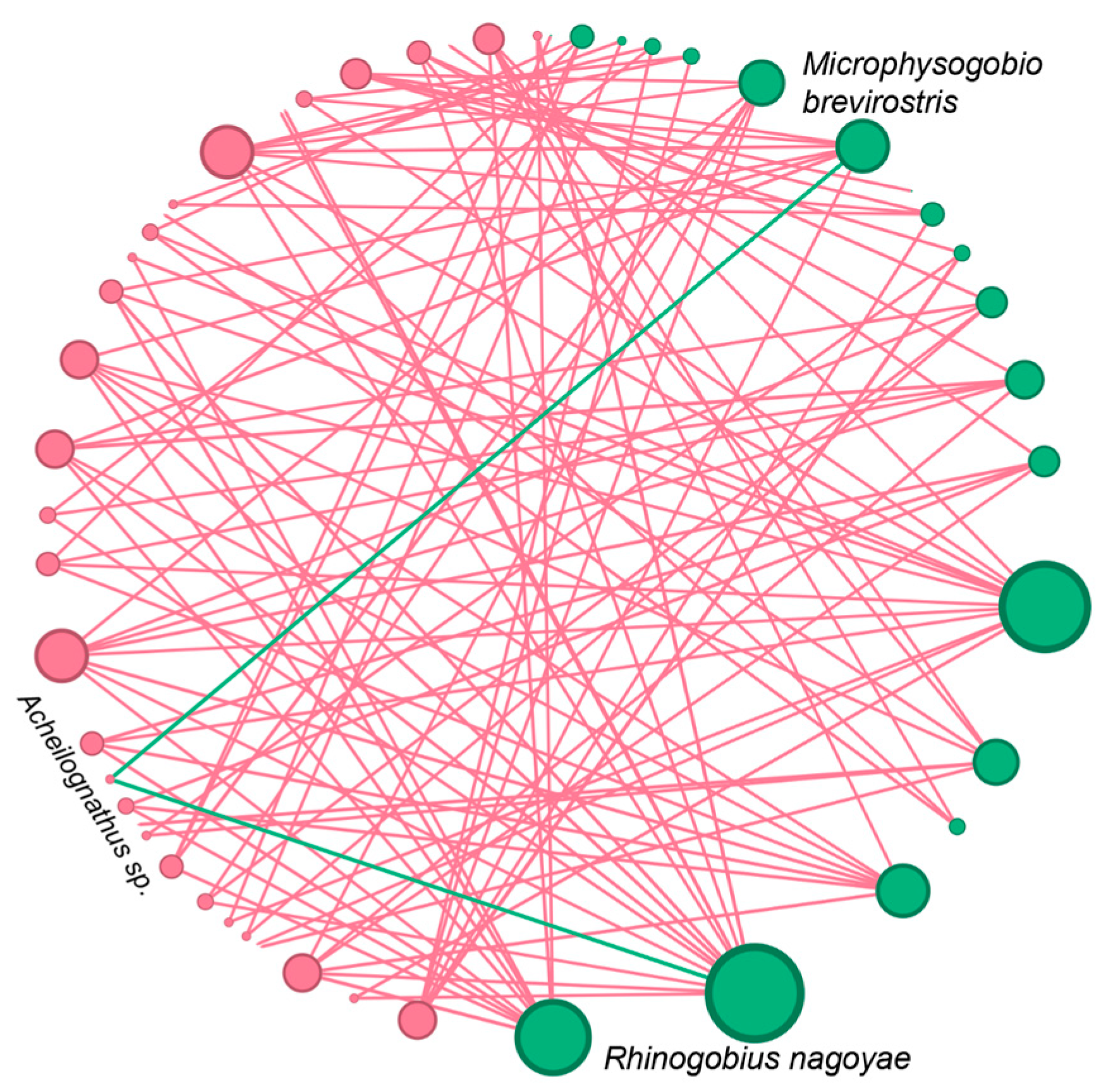Environmental DNA-Based Identification of Non-Native Fish in Beijing: Diversity, Geographical Distribution, and Interactions with Native Taxa
Abstract
:Simple Summary
Abstract
1. Introduction
2. Materials and Methods
2.1. Sampling
2.2. eDNA Purification, PCR Amplification, and Sequencing
2.3. Bioinformatic Analysis
2.4. Data Analysis
3. Results
3.1. Fish Diversity
3.2. Geographical Distribution of Fish Diversity
3.3. Interactions among Fish Taxa
4. Discussion
4.1. Monitoring Diverse Non-Native Fish
4.2. Geographical Distribution of Fish in Beijing
4.3. Interactions among Fish Taxa
5. Conclusions
Supplementary Materials
Author Contributions
Funding
Institutional Review Board Statement
Informed Consent Statement
Data Availability Statement
Acknowledgments
Conflicts of Interest
References
- Marques, P.S.; Manna, L.R.; Frauendorf, T.C.; Zandonà, E.; Mazzoni, R.; El-Sabaawi, R. Urbanization can increase the invasive potential of alien species. J. Anim. Ecol. 2020, 89, 2345–2355. [Google Scholar] [CrossRef]
- González-Lagos, C.; Cardador, L.; Sol, D. Invasion success and tolerance to urbanization in birds. Ecography 2021, 44, 1642–1652. [Google Scholar] [CrossRef]
- Zhang, S.; Zheng, Y.; Zhan, A.; Dong, C.; Zhao, J.; Yao, M. Environmental DNA captures native and non-native fish community variations across the lentic and lotic systems of a megacity. Sci. Adv. 2022, 8, eabk0097. [Google Scholar] [CrossRef] [PubMed]
- Li, S.; Wei, H.; Vilizzi, L.; Zhan, A.; Olden, J.D.; Preston, D.L.; Clarke, S.A.; Cudmore, B.; Davies, G.D.; Wang, X.; et al. The future of legislation, policy, risk analysis, and management of non-native freshwater fishes in China. Rev. Fish. Sci. Aquac. 2020, 29, 149–166. [Google Scholar] [CrossRef]
- Du, Y.; Xi, Y.; Yang, Z.; Gu, D.; Zhang, Z.; Tu, W.; Zeng, Y.; Cui, R.; Yan, Z.; Xin, Y.; et al. High risk of biological invasion from prayer animal release in China. Front. Ecol. Environ. 2024, 22, e2647. [Google Scholar] [CrossRef]
- Zhan, A.; Zhang, L.; Xia, Z.; Ni, P.; Xiong, W.; Chen, Y.; Haffner, D.G.; MacIsaac, H.J. Water diversions facilitate spread of non-native species. Biol. Invasions 2015, 17, 3073–3080. [Google Scholar] [CrossRef]
- Guo, W.; Li, S.; Zhan, A. eDNA-based early detection illustrates rapid spread of the non-native golden mussel introduced into Beijing via water diversion. Animals 2024, 14, 399. [Google Scholar] [CrossRef]
- Wang, H.; Xia, Z.; Li, S.; MacIsaac, H.J.; Zhan, A. What’s coming eventually comes: A follow-up on an invader’s spread by the world’s largest water diversion in China. Biol. Invasions 2023, 25, 1–5. [Google Scholar] [CrossRef]
- Xia, Z.; Gu, J.; Wen, Y.; Cao, X.; Gao, Y.; Li, S.; Haffner, G.D.; MacIsaac, H.J.; Zhan, A. eDNA-based detection reveals invasion risks of a biofouling bivalve in the world’s largest water diversion project. Ecol. Appl. 2024, 34, e2826. [Google Scholar] [CrossRef]
- Francis, R.A.; Chadwick, M.A.; Turbelin, A.J. An overview of non-native species invasions in urban river corridors. River Res. Appl. 2019, 35, 1269–1278. [Google Scholar] [CrossRef]
- Prokopuk, M.; Zub, L. Urban ecosystems as locations of distribution of alien aquatic plants. Folia Oecol. 2000, 47, 159–167. [Google Scholar] [CrossRef]
- Xiong, W.; Ni, P.; Chen, Y.; Gao, Y.; Shan, B.; Zhan, A. Zooplankton community structure along a pollution gradient at fine geographical scales in river ecosystems: The importance of species sorting over dispersal. Mol. Ecol. 2017, 26, 4351–4360. [Google Scholar] [CrossRef]
- Crooks, J.A.; Chang, A.L.; Ruiz, G.M. Aquatic pollution increases the relative success of invasive species. Biol. Invasions 2011, 13, 165–176. [Google Scholar] [CrossRef]
- Morin-Crini, N.; Lichtfouse, E.; Liu, G.; Balaram, V.; Ribeiro, A.R.L.; Lu, Z.; Stock, F.; Carmona, E.; Teixeira, M.R.; Picos-Corrales, L.A.; et al. Worldwide cases of water pollution by emerging contaminants: A review. Environ. Chem. Lett. 2022, 20, 2311–2338. [Google Scholar] [CrossRef]
- Santamaría, J.; Tomas, F.; Ballesteros, E.; Ruiz, J.M.; Bernardeau-Esteller, J.; Terrados, J.; Cebrian, E. The role of competition and herbivory in biotic resistance against invaders: A synergistic effect. Ecology 2021, 102, e03440. [Google Scholar] [CrossRef] [PubMed]
- McKinney, M.L. Urbanization as a major cause of biotic homogenization. Biol. Conserv. 2006, 127, 247–260. [Google Scholar] [CrossRef]
- Yu, R.; Wu, Q.; Li, F.; Zhan, A.; Zhou, J.; Li, S. Risk screening of invasive aquatic species and a survey of fish diversity using environmental DNA metabarcoding analysis in Shanghai. Diversity 2024, 16, 29. [Google Scholar] [CrossRef]
- Zhang, C.; Zhao, Y.; Xing, Y.; Guo, R.; Zhang, Q.; Feng, Y.; Fan, E. Fish species diversity and conservation in Beijing and adjacent areas. Biodivers. Sci. 2011, 19, 597. [Google Scholar]
- Wang, S.; Yan, Z.; Hänfling, B.; Zheng, X.; Wang, P.; Fan, J.; Li, J. Methodology of fish eDNA and its applications in ecology and environment. Sci. Total Environ. 2021, 755, 142622. [Google Scholar] [CrossRef]
- Xiong, W.; MacIsaac, H.J.; Zhan, A. An overlooked source of false positives in eDNA-based biodiversity assessment and management. J. Environ. Manag. 2024, 358, 120949. [Google Scholar] [CrossRef]
- Harvey, C.T.; Qureshi, S.A.; MacIsaac, H.J. Detection of a colonizing, aquatic, non-indigenous species. Divers. Distrib. 2009, 15, 429–437. [Google Scholar] [CrossRef]
- Thomsen, P.F.; Kielgast, J.; Iversen, L.L.; Møller, P.R.; Rasmussen, M.; Willerslev, E. Detection of a diverse marine fish fauna using environmental DNA from seawater samples. PLoS ONE 2012, 7, e41732. [Google Scholar] [CrossRef] [PubMed]
- Duenas, M.A.; Hemming, D.J.; Roberts, A.; Diaz-Soltero, H. The threat of invasive species to IUCN-listed critically endangered species: A systematic review. Glob. Ecol. Conserv. 2021, 26, e01476. [Google Scholar]
- Yuan, S.; Zhang, W.; Li, W.; Li, Z.; Wu, M.; Shan, B. Shifts in the bacterial community caused by combined pollutant loads in the North Canal River, China. J. Environ. Sci. 2023, 127, 541–551. [Google Scholar]
- Hunter, M.E.; Ferrante, J.A.; Meigs-Friend, G.; Ulmer, A. Improving eDNA yield and inhibitor reduction through increased water volumes and multi-filter isolation techniques. Sci. Rep. 2019, 9, 5259. [Google Scholar] [CrossRef] [PubMed]
- Valentini, A.; Taberlet, P.; Miaud, C.; Civade, R.; Herder, J.; Thomsen, P.F.; Bellemain, E.; Besnard, A.; Coissac, E.; Boyer, F. Next-generation monitoring of aquatic biodiversity using environmental DNA metabarcoding. Mol. Ecol. 2015, 25, 929–942. [Google Scholar] [CrossRef]
- Juhel, J.; Utama, R.S.; Marquès, V.; Vimono, I.B.; Sugeha, H.Y.; Kadarusman, K.; Pouyaud, L.; Dejean, T.; Mouillot, D.; Hocdé, R. Accumulation curves of environmental DNA sequences predict coastal fish diversity in the coral triangle. Proc. R. Soc. B-Biol. Sci. 2020, 287, 20200248. [Google Scholar] [CrossRef] [PubMed]
- Xiong, W.; Zhan, A. Testing clustering strategies for metabarcoding-based investigation of community-environment interactions. Mol. Ecol. Resour. 2018, 18, 1326–1338. [Google Scholar] [CrossRef]
- Bastian, M.; Heymann, S.; Jacomy, M. Gephi: An open source software for exploring and manipulating networks. In Proceedings of the International AAAI Conference on Web and Social Media, San Jose, CA, USA, 17–20 May 2009; Volume 3, pp. 361–362. [Google Scholar]
- Clarke, K.R.; Gorley, R.N. PRIMER v6: User Manual/Tutorial; PRIMER-E: Plymouth, UK, 2006; Available online: http://www.primer-e.com/ (accessed on 11 August 2024).
- Csárdi, G.; Nepusz, T.; Traag, V.; Horvát, S.; Zanini, F.; Noom, D.; Müller, K. igraph: Network Analysis and Visualization in R. R Package Version 2.0.3. 2024. Available online: https://CRAN.R-project.org/package=igraph (accessed on 11 August 2024).
- McKinney, M.L.; Lockwood, J.L. Biotic homogenization: A few winners replacing many losers in the next mass extinction. Trends Ecol. Evol. 1999, 14, 450–453. [Google Scholar] [CrossRef]
- Olden, J.D.; Poff, N.L. Toward a mechanistic understanding and prediction of biotic homogenization. Am. Nat. 2003, 162, 442–460. [Google Scholar]
- García-Berthou, E.; Alcaraz, C.; Pou-Rovira, Q.; Zamora, L.; Coenders, G.; Feo, C. Introduction pathways and establishment rates of invasive aquatic species in Europe. Can. J. Fish. Aquat. Sci. 2005, 62, 453–463. [Google Scholar] [CrossRef]
- Cuthbert, R.N.; Kotronaki, S.G.; Carlton, J.T.; Ruiz, G.M.; Fofonoff, P.; Briski, E. Aquatic invasion patterns across the North Atlantic. Glob. Chang. Biol. 2022, 28, 1376–1387. [Google Scholar] [CrossRef]
- Fagan, W.F.; Lewis, M.A.; Neubert, M.G.; Van Den Driessche, P. Invasion theory and biological control. Ecol. Lett. 2002, 5, 148–157. [Google Scholar] [CrossRef]
- Zhang, S.; Bi, Y.; Zhao, J.; Yao, M. To the north: eDNA tracing of the seasonal and spatial dynamics of fish assemblages along the world’s largest water diversion project. J. Environ. Manag. 2023, 331, 117217. [Google Scholar] [CrossRef]
- Briski, E.; Chan, F.T.; Darling, J.A.; Lauringson, V.; MacIsaac, H.J.; Zhan, A.; Bailey, S.A. Beyond propagule pressure: Importance of selection during the transport stage of biological invasions. Front. Ecol. Environ. 2018, 16, 345–353. [Google Scholar] [CrossRef] [PubMed]
- Simberloff, D. The role of propagule pressure in biological invasions. Annu. Rev. Ecol. Evol. Syst. 2009, 40, 81–102. [Google Scholar] [CrossRef]
- Zhan, A.; Hulák, M.; Sylvester, F.; Huang, X.; Adebayo, A.A.; Abbott, C.L.; Adamowicz, S.J.; Heath, D.D.; Cristescu, M.E.; MacIsaac, H.J. High sensitivity of 454 pyrosequencing for detection of rare species in aquatic communities. Methods Ecol. Evol. 2013, 4, 558–565. [Google Scholar] [CrossRef]
- Beng, K.C.; Corlett, R.T. Applications of environmental DNA (eDNA) in ecology and conservation: Opportunities, challenges and prospects. Biodivers. Conserv. 2020, 29, 2089–2121. [Google Scholar] [CrossRef]
- Castro, K.L.; Battini, N.; Giachetti, C.B.; Trovant, B.; Abelando, M.; Basso, N.G.; Schwindt, E. Early detection of marine invasive species following the deployment of an artificial reef: Integrating tools to assist the decision-making process. J. Environ. Manag. 2021, 297, 113333. [Google Scholar] [CrossRef] [PubMed]
- Darling, J.A.; Blum, M.J. DNA-based methods for monitoring invasive species: A review and prospectus. Biol. Invasion 2007, 9, 751–765. [Google Scholar] [CrossRef]
- Xiong, W.; Li, H.; Zhan, A. Early detection of invasive species in marine ecosystems using high-throughput sequencing: Technical challenges and possible solutions. Mar. Biol. 2016, 163, 139. [Google Scholar] [CrossRef]
- Goldberg, C.S.; Turner, C.; Deiner, K.; Klymus, K.E.; Thomsen, P.F.; Murphy, M.A.; Spear, S.F.; McKee, A.M.; Oyler-McCance, S.J.; Cornman, R.S.; et al. Critical considerations for the application of environmental DNA methods to detect aquatic species. Methods Ecol. Evol. 2016, 7, 1299–1307. [Google Scholar] [CrossRef]
- Jane, S.F.; Wilcox, T.M.; McKelvey, K.S.; Young, M.K.; Schwartz, M.K.; Lowe, W.H.; Letcher, B.H.; Whiteley, A.R. Distance, flow and PCR inhibition: eDNA dynamics in two headwater streams. Mol. Ecol. Resour. 2015, 15, 216–227. [Google Scholar] [CrossRef]
- Carraro, L.; Stauffer, J.B.; Altermatt, F. How to design optimal eDNA sampling strategies for biomonitoring in river networks. Environ. DNA 2020, 3, 157–172. [Google Scholar] [CrossRef]
- Chen, X.; Kong, Y.; Zhang, S.; Zhao, J.; Li, S.; Yao, M. Comparative evaluation of common materials as passive samplers of environmental DNA. Environ. Sci. Technol. 2022, 56, 10798–10807. [Google Scholar] [CrossRef]
- Chen, X.; Li, S.; Zhao, J.; Yao, M. Passive eDNA sampling facilitates biodiversity monitoring and rare species detection. Environ. Int. 2024, 187, 108706. [Google Scholar] [CrossRef]
- Xia, Z.; Zhan, A.; Johansson, M.L.; DeRoy, E.; Haffner, G.D.; MacIsaac, H.J. Screening marker sensitivity: Optimizing eDNA-based rare species detection. Diver. Distrib. 2021, 27, 1981–1988. [Google Scholar] [CrossRef]
- Pernet-Coudrier, B.; Qi, W.; Liu, H.; Müller, B.; Berg, M. Sources and pathways of nutrients in the semi-arid region of Beijing–Tianjin, China. Environ. Sci. Technol. 2012, 46, 5294–5301. [Google Scholar] [CrossRef]
- Scriver, M.; Zaiko, A.; Pochon X von Ammon, U. Harnessing decay rates for coastal marine biosecurity applications: A review of environmental DNA and RNA fate. Environ. DNA 2023, 5, 960–972. [Google Scholar] [CrossRef]
- Jerde, C.L.; Mahon, A.R.; Campbell, T.; McElroy, M.E.; Pin, K.; Childress, J.N.; Armstrong, M.N.; Zehnpfennig, J.R.; Kelson, S.J.; Koning, A.A.; et al. Are genetic reference libraries sufficient for environmental DNA metabarcoding of Mekong River basin fish? Water 2021, 13, 1767. [Google Scholar] [CrossRef]
- Lim, S.J.; Thompson, L.R. Mitohelper: A mitochondrial reference sequence analysis tool for fish eDNA studies. Environ. DNA 2021, 3, 706–715. [Google Scholar] [CrossRef]
- Olden, J.D.; Kennard, M.J.; Leprieur, F.; Tedesco, P.A.; Winemiller, K.O.; García-Berthou, E. Conservation biogeography of freshwater fishes: Recent progress and future challenges. Divers. Distrib. 2010, 16, 496–513. [Google Scholar] [CrossRef]
- Leroy, B.; Dias, M.S.; Giraud, E.; Hugueny, B.; Jézéquel, C.; Leprieur, F.; Oberdorff, T.; Tedesco, P.A. Global biogeographical regions of freshwater fish species. J. Biogeogr. 2019, 46, 2407–2419. [Google Scholar] [CrossRef]
- Griffiths, D. Why does freshwater fish species richness differ between Pacific and Atlantic drainages of the Americas? J. Biogeogr. 2018, 45, 784–792. [Google Scholar] [CrossRef]
- He, D.; Sui, X.; Sun, H.; Tao, J.; Ding, C.; Chen, Y.; Chen, Y. Diversity, pattern and ecological drivers of freshwater fish in China and adjacent areas. Rev. Fish Biol. Fish. 2020, 30, 387–404. [Google Scholar] [CrossRef]
- Marchetti, M.P.; Lockwood, J.L.; Light, T. Effects of urbanization on California’s fish diversity: Differentiation, homogenization and the influence of spatial scale. Biol. Conserv. 2006, 127, 310–318. [Google Scholar] [CrossRef]
- Cruz, L.C.; Pompeu, P.S. Drivers of fish assemblage structures in a Neotropical urban watershed. Urban Ecosyst. 2020, 23, 819–829. [Google Scholar] [CrossRef]
- Lokatis, S.; Jeschke, J.M. Urban biotic homogenization: Approaches and knowledge gaps. Ecol. Appl. 2022, 32, e2703. [Google Scholar] [CrossRef]
- Liu, P.; Xu, S.; Lin, J.; Li, H.; Lin, Q.; Han, B.P. Urbanization increases biotic homogenization of zooplankton communities in tropical reservoirs. Ecol. Indic. 2020, 110, 105899. [Google Scholar] [CrossRef]
- Peronico, P.B.; Agostinho, C.S.; Fernandes, R.; Pelicice, F.M. Community reassembly after river regulation: Rapid loss of fish diversity and the emergence of a new state. Hydrobiologia 2020, 847, 519–533. [Google Scholar] [CrossRef]
- Scott, M.C.; Helfman, G.S. Native invasions, homogenization, and the mismeasure of integrity of fish assemblages. Fisheries 2001, 26, 6–15. [Google Scholar] [CrossRef]
- Havel, J.E.; Kovalenko, K.E.; Thomaz, S.M.; Amalfitano, S.; Kats, L.B. Aquatic invasive species: Challenges for the future. Hydrobiologia 2015, 750, 147–170. [Google Scholar] [CrossRef] [PubMed]
- Hänfling, B. Understanding the establishment success of non-indigenous fishes: Lessons from population genetics. J. Fish Biol. 2007, 71, 115–135. [Google Scholar] [CrossRef]
- Bøhn, T.; Amundsen, P.A.; Sparrow, A. Competitive exclusion after invasion? Biol. Invasions 2008, 10, 359–368. [Google Scholar] [CrossRef]
- Doherty, T.S.; Glen, A.S.; Nimmo, D.G.; Ritchie, E.G.; Dickman, C.R. Invasive predators and global biodiversity loss. Proc. Natl. Acad. Sci. USA 2016, 113, 11261–11265. [Google Scholar] [CrossRef]
- Didham, R.K.; Tylianakis, J.M.; Gemmell, N.J.; Rand, T.A.; Ewers, R.M. Interactive effects of habitat modification and species invasion on native species decline. Trends Ecol. Evol. 2007, 22, 489–496. [Google Scholar] [CrossRef]
- Didham, R.K.; Tylianakis, J.M.; Hutchison, M.A.; Ewers, R.M.; Gemmell, N.J. Are invasive species the drivers of ecological change? Trends Ecol. Evol. 2005, 20, 470–474. [Google Scholar] [CrossRef]
- Li, Z.; Sun, Z.; Zhang, L.; Zhan, N.; Lou, C.; Lian, J. Investigation of water quality and aquatic ecological succession of a newly constructed river replenished by reclaimed water in Beijing. Heliyon 2023, 9, e17045. [Google Scholar] [CrossRef]
- Wang, W.; Tang, X.Q.; Huang, S.L.; Zhang, S.H.; Lin, C.; Liu, D.W.; Che, H.J.; Yang, Q.; Scholz, M. Ecological restoration of polluted plain rivers within the Haihe River Basin in China. Wat. Air Soil Poll. 2010, 211, 341–357. [Google Scholar] [CrossRef]
- Xiong, W.; Chen, Y.; Zhan, A. Dominance of species sorting over dispersal at microgeographical scales in polluted lotic ecosystems. Environ. Poll. 2023, 333, 122093. [Google Scholar] [CrossRef]
- Hu, X.; Zuo, D.; Xu, Z.; Huang, Z.; Liu, B.; Han, Y.; Bi, Y. Response of macroinvertebrate community to water quality factors and aquatic ecosystem health assessment in a typical river in Beijing, China. Environ. Res. 2022, 212, 113474. [Google Scholar] [CrossRef] [PubMed]
- Zefferman, E.; Stevens, J.T.; Charles, G.K.; Dunbar-Irwin, M.; Emam, T.; Fick, S.; Morales, L.V.; Wolf, K.M.; Young, D.J.; Young, T.P. Plant communities in harsh sites are less invaded: A summary of observations and proposed explanations. AoB Plants 2015, 7, plv056. [Google Scholar] [CrossRef] [PubMed]
- Shea, K.; Chesson, P. Community ecology theory as a framework for biological invasions. Trends Ecol. Evol. 2002, 17, 170–176. [Google Scholar] [CrossRef]
- Von Holle, B. Environmental stress alters native-nonnative relationships at the community scale. Biol. Invasions 2013, 15, 417–427. [Google Scholar] [CrossRef]





| Daqing River | North Canal | Ji Canal | All | |
|---|---|---|---|---|
| No. of zOTUs (average) | 54–117 (83.0) | 37–117 (70.2) | 69–114 (83.0) | 37–117 (78.7) |
| No. of fish taxa (average) | 17–44 (31.3) | 24–39 (31.5) | 31–44 (36.1) | 17–44 (33.0) |
| No. of non-native fish taxa (average) | 4–16 (9.0) | 1–14 (6.4) | 6–12 (8.7) | 1–16 (8.0) |
| No. of native fish taxa (average) | 20–36 (27.5) | 16–33 (24.9) | 24–32 (27.4) | 16–36 (26.6) |
| Species richness—non-native (average) | 0.61–2.27 (1.37) | 0–2.16 (1.10) | 1.02–1.97 (1.55) | 0–2.27 (1.34) |
| Species richness—native (average) | 1.91–3.19 (2.42) | 1.51–3.23 (2.39) | 2.03–2.84 (2.61) | 1.51–3.23 (7.42) |
| Simpson’s Index—non-native (average) | 0.45–0.91 (0.75) | 0–0.87 (0.59) | 0.74–0.89 (0.83) | 0–0.91 (0.72) |
| Simpson’s Index—native (average) | 0.38–0.85 (0.63) | 0.04–0.87 (0.55) | 0.21–0.77 (0.58) | 0.04–0.87 (0.59) |
| Pielou’s evenness—non-native (average) | 0.60–0.90 (0.81) | 0–0.93 (0.66) | 0.82–0.93 (0.88) | 0–0.93 (0.78) |
| Pielou’s evenness—native (average) | 0.25–0.63 (0.48) | 0.05–0.72 (0.43) | 0.20–0.63 (0.45) | 0.05–0.72 (0.45) |
| Non-Native Species | Common Name | Native Range | Invasion History? | Year of First Detection |
|---|---|---|---|---|
| Acheilognathus rhombeus | Korean flat bittering | Japan, Republic of Korea | Y | 2018 |
| Channa striata | Striped snakehead | South and Southeast Asia | Y | This study |
| Coptodon zillii | Redbelly tilapia | Northern Africa, the Middle East | Y | This study |
| Gambusia affinis | Mosquito fish | North America | Y | This study |
| Gobio gobio | Common gudgeon | Central and temperate Eurasia | Y | 2021 |
| Gobio soldatovi | Soldatov’s gudgeon | Amur River, Sakhalin Island, Lake Buir | N | This study |
| Hypomesus nipponensis | Japanese smelt | Japan, Republic of Korea, Russia | Y | This study |
| Ictalurus punctatus | Channel catfish | North America, Mexico | Y | 2018 |
| Microphysogobio brevirostris | Short-nose gudgeon | Taiwan, China | N | This study |
| Odontobutis potamophila | Dark sleeper | South China, Vietnam | Y | 2018 |
| Oreochromis niloticus | Nile tilapia | Africa, the Levant | Y | 2020 |
| Osteochilus salsburyi | - | Laos, Vietnam, Southern China | N | This study |
| Rhinogobius nagoyae | Nagoya goby | Republic of Korea, Japan | Y | 2018 |
| Species | Abund. % (Av.) % | Daqing River Basin | North Canal Basin | Ji Canal Basin | |||
|---|---|---|---|---|---|---|---|
| det.?/ %det. | Abund. (Av.) % | det.?/ %det. | Abund. % (Av.) % | det.?/ %det. | Abund. % (Av.) % | ||
| Acheilognathus rhombeus | <0.01–0.73 (0.20) | Y/12.5 | 0.14 (-) | Y/7.7 | 0.02–0.53 (0.21) | Y/42.9 | <0.01–0.73 (0.37) |
| Barbatula sp. | 0.01–0.65 (0.11) | Y/62.5 | 0.01–0.20 (0.09) | Y/71.2 | 0.01–0.65 (0.13) | Y/85.7 | 0.01–0.21 (0.10) |
| Centrarchidae sp. | 0.01–0.14 (0.04) | Y/37.5 | 0.03–0.14 (0.07) | Y/9.6 | 0.01–0.07 (0.03) | N | - |
| Channa striata | 0.04 (-) | Y/12.5 | 0.04–0.04 (0.04) | N | - | N | - |
| Cichlidae sp. | 0.01–0.56 (0.11) | Y/100.0 | 0.01–0.22 (0.10) | Y/78.8 | 0.01–0.40 (0.10) | Y/85.7 | 0.03–0.56 (0.27) |
| Clarias sp. | 0.01–0.09 (0.03) | Y/50.0 | 0.01–0.09 (0.03) | Y/25.0 | 0.01–0.09 (0.04) | Y/42.9 | 0.01–0.03 (0.02) |
| Coptodon zillii | <0.01–0.32 (0.08) | Y/87.5 | <0.01–0.31 (0.07) | Y/69.2 | 0.01–0.32 (0.10) | Y/85.7 | 0.03–0.21 (0.10) |
| Gambusia affinis | <0.01 (-) | Y/12.5 | <0.01 (-) | N | - | N | - |
| Gobio gobio | <0.01–0.10 (0.02) | Y/37.5 | <0.01–0.02 (0.01) | Y/19.2 | <0.01–0.10 (0.02) | Y/14.3 | 0.01–0.01 (0.01) |
| Gobio soldatovi | <0.01–0.45 (0.11) | Y/50.0 | <0.01–0.14 (0.04) | Y/21.2 | 0.01–0.45 (0.14) | Y/42.9 | 0.01–0.30 (0.15) |
| Gymnogobius sp. | 0.01–0.05 (0.03) | Y/12.5 | 0.04–0.04 (0.04) | Y/5.8 | 0.01–0.03 (0.02) | Y/14.3 | 0.05–0.05 (0.05) |
| Hypomesus nipponensis | <0.01–0.10 (0.04) | Y/25.0 | <0.01–0.02 (0.01) | Y/7.7 | <0.01–0.09 (0.04) | Y/14.3 | 0.10–0.10 (0.10) |
| Ictalurus punctatus | <0.01–0.78 (0.10) | Y/50.0 | <0.01–0.31 (0.12) | Y/26.9 | <0.01–0.78 (0.14) | Y/14.3 | 0.08–0.08 (0.08) |
| Lepomis sp. | 0.18 (-) | N | - | Y/1.9 | 0.18 (-) | N | - |
| Microphysogobio brevirostris | 0.01–0.04 (0.03) | Y/37.5 | 0.03–0.04 (0.04) | Y/3.8 | 0.01–0.03 (0.02) | Y/14.3 | 0.01–0.01 (0.01) |
| Odontobutis potamophila | <0.01–8.73 (0.47) | Y/75.0 | <0.01–0.13 (0.07) | Y/69.2 | 0.01–8.73 (0.83) | Y/71.4 | 0.01–0.11 (0.06) |
| Oreochromis niloticus | <0.01–0.15 (0.03) | Y/25.0 | 0.04–0.06 (0.05) | Y/50.0 | <0.01–0.15 (0.03) | Y/85.7 | 0.02–0.10 (0.07) |
| Oreochromis sp. | <0.01–0.26 (0.06) | Y/62.5 | 0.02–0.26 (0.09) | Y/59.6 | <0.01–0.17 (0.06) | Y/85.7 | 0.02–0.06 (0.04) |
| Osteochilus salsburyi | <0.01–1.04 (0.11) | Y/25.0 | <0.01–0.13 (0.07) | Y/44.2 | <0.01–1.04 (0.16) | Y/71.4 | 0.03–0.21 (0.12) |
| Rhinogobius nagoyae | <0.01–1.21 (0.17) | Y/87.5 | 0.01–0.18 (0.09) | Y/65.4 | <0.01–1.21 (0.23) | Y/100.0 | 0.01–0.21 (0.11) |
Disclaimer/Publisher’s Note: The statements, opinions and data contained in all publications are solely those of the individual author(s) and contributor(s) and not of MDPI and/or the editor(s). MDPI and/or the editor(s) disclaim responsibility for any injury to people or property resulting from any ideas, methods, instructions or products referred to in the content. |
© 2024 by the authors. Licensee MDPI, Basel, Switzerland. This article is an open access article distributed under the terms and conditions of the Creative Commons Attribution (CC BY) license (https://creativecommons.org/licenses/by/4.0/).
Share and Cite
Liu, B.; Wang, F.; Li, S.; Xiong, W.; Zhan, A. Environmental DNA-Based Identification of Non-Native Fish in Beijing: Diversity, Geographical Distribution, and Interactions with Native Taxa. Animals 2024, 14, 2532. https://doi.org/10.3390/ani14172532
Liu B, Wang F, Li S, Xiong W, Zhan A. Environmental DNA-Based Identification of Non-Native Fish in Beijing: Diversity, Geographical Distribution, and Interactions with Native Taxa. Animals. 2024; 14(17):2532. https://doi.org/10.3390/ani14172532
Chicago/Turabian StyleLiu, Bo, Fuwen Wang, Shiguo Li, Wei Xiong, and Aibin Zhan. 2024. "Environmental DNA-Based Identification of Non-Native Fish in Beijing: Diversity, Geographical Distribution, and Interactions with Native Taxa" Animals 14, no. 17: 2532. https://doi.org/10.3390/ani14172532





